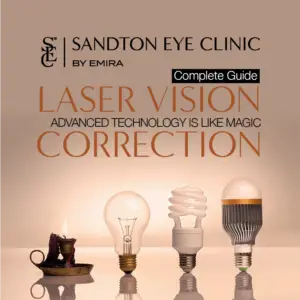
Do you remember the thrill of putting on your first pair of glasses and finally seeing the world clearly? Or the newfound freedom you felt with your first contact lens? Now, imagine waking up tomorrow morning, opening your eyes, and seeing everything sharply—without any lenses.
Have you been told that LASIK isn’t an option for you? Just like cell phones and computers, Laser Vision Correction has made incredible advancements. If you haven’t had a comprehensive examination by a refractive surgeon, there’s still hope. LASIK has evolved, and there are now many other vision correction procedures we can offer even if LASIK is not for you.
Choosing to see clearly without glasses is a life-changing decision. We know you may have many questions, which is why we’ve created this comprehensive guide to help you navigate your journey to better vision.
1. Glasses, Contacts and Laser Vision Correction: How Do You Choose?
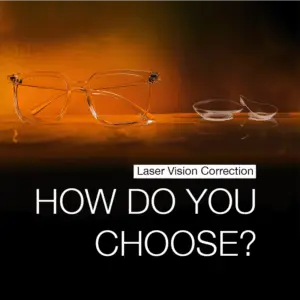
Glasses vs. Contact Lenses: When it comes to eye safety, glasses are the clear winner over contact lenses. While severe side effects from contact lenses are rare, they can be serious. Familiarity often leads to carelessness, increasing the risk. Most complications with contact lenses are hygiene-related, and not everyone tolerates them well, even with a proper fit. However, for those who prioritize lifestyle over convenience, contact lenses can offer significant benefits—provided good hygiene is maintained.
Glasses vs. LASIK: Glasses are the safest option, as they involve no medical procedures. If you’re content with glasses, LASIK may not be necessary. However, LASIK has become incredibly safe, thanks to advancements in technology. It’s a procedure that combines art and precision, where the surgeon’s skill is crucial. For active individuals or those in professions where visual aids are impractical, the benefits of LASIK can outweigh the risks.
LASIK vs. Contact lenses: Statistically, LASIK is safer than long-term contact lens use, with fewer side effects and higher satisfaction rates. Studies show LASIK patients have fewer nighttime driving difficulties and dry eye symptoms compared to contact lens wearers.
Of all three options—glasses, contact lenses, and LASIK—LASIK offers the best balance between safety and lifestyle benefits. If you’ve already chosen contact lenses for lifestyle reasons, LASIK should be the next logical step.
2. Why Do So Many People Choose Laser Vision Correction?
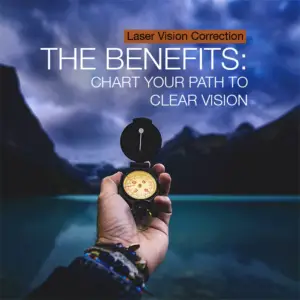
Each year, millions opt for the freedom of LASIK or other vision correction procedures over glasses and contacts. It’s a transformative decision.
1 The Freedom: Many of our patients say, “Best decision ever. Why didn’t I do it sooner?” Choosing sight without glasses or contacts is life-changing. It is a privilege to be free to just get up and go, dive in and swim and enjoy the comfort of seeing clearly with your own eyes and nothing else.
2 Saving Money: Beyond the priceless experience of seeing without visual aids, LASIK can save you money over time. Have you ever calculated how much you spend on glasses and contact lenses? Cheap solutions often end up costing more in the long run.
3 Time is Precious: Imagine not needing to clean your contacts twice a day. Laser vision correction can save you 10 minutes daily, equating to 60 hours annually. Plus, consider the time spent searching for misplaced glasses and readers.
4 Safety First: LASIK is one of the safest and most effective elective surgeries available, with serious complications being extremely rare and usually manageable. In fact, contact lens wearers face a ten times higher risk of sight-threatening infections than LASIK patients. While glasses are safe due to the lack of a procedure, they can become a liability in critical situations where losing or breaking them poses a danger.
5 Going Green: Laser Vision Correction (LVC) provides a sustainable alternative by reducing long-term waste. Procedures like LASIK offer permanent vision correction, significantly decreasing reliance on disposable or short-lived vision aids. This eco-friendly choice reduces the environmental impact associated with the ongoing production, packaging, and disposal of glasses and contact lenses.
6 Work Better & Play Better: Whether at work or during your favourite activities, life is easier without the hassle of glasses or the risk of contact lenses getting dislodged. From safer job performance to more enjoyable hobbies and sports, you’ll find everything is smoother and more enjoyable when you’re free from the limitations of corrective eyewear.
7 Look Better & See Better: Remember the amazing vision you had with your first pair of glasses or contact lenses? Now imagine waking up tomorrow with clear vision, no lenses needed. Many people prefer how they look without glasses, which is why they endure the discomfort and expense of contacts. With LASIK, you can skip the lenses altogether and possibly achieve better vision than glasses or contacts ever provided.
8 Contact Lens Intolerance: Contacts can irritate your eyes and require constant upkeep, and many people eventually become intolerant to them. If you experience discomfort while wearing contacts, it’s often misattributed to dry eyes. In reality, soft lenses absorb your tears, leading to itchy or gritty sensations. This doesn’t necessarily mean your eyes are dry. In fact, about 6 million people in the U.S. each year find they can no longer tolerate contact lenses.
3. What is the Best Age Get Laser Vision Correction?
Vision correction is not a one-size-fits-all solution. Your options vary based on your age, prescription, and lifestyle. Your refractive surgeon will guide you in choosing the most effective treatment for long-term clear vision. Here’s a breakdown of what to consider at different life stages:
Before Age 18
Because the eyes are still growing, there are no surgical options to permanently correct vision before 18. Glasses are the primary option for childhood vision correction. While some children may be able to wear contact lenses, it’s usually recommended only for those who can handle the responsibility of proper care to avoid infections.
Myopia control is crucial during childhood to prevent worsening vision. Techniques like low-dose Atropine eye drops, peripheral defocus contact lenses, and Orthokeratology (Ortho-K) lenses are available to slow the progression of myopia. Studies show that spending at least 2 hours playing outside in natural light every day can reduce myopia progression in children. Try to limit the use of digital devices and balance screen time and outdoor time.
Getting LASIK at 18 offers long-lasting clear vision and the greatest improvement in quality of life. You’ll save on glasses and contacts, and younger patients heal quickly. LASIK is a 15-minute outpatient procedure that reshapes the cornea to correct near-sightedness, farsightedness, and astigmatism. Most people can return to work the next day.
For those with dry eyes, LALEX is a similar procedure but without a corneal flap, making it a good alternative. PRK is ideal for those with thin corneas or who play contact sports. It offers similar long-term results to LASIK but requires longer recovery due to the regrowth of the corneal epithelium.
For very high prescriptions or thin corneas, Implantable Contact Lenses are a better option. This procedure involves placing an artificial lens in front of your natural one, with quick recovery and excellent outcomes, though at a higher cost.
Age 40-55
At 40, whether you’ve worn glasses for years or just started using readers, this is the ideal age for blended vision correction to eliminate the need for reading glasses. Treatment options are similar to those for younger patients, with specialized laser calculations or lenses to correct vision at all distances.
PresbyLASIK is often the first choice, but depending on your eye anatomy, PresbyPRK, Allotex Allograft Inlay or Implantable Contact Lenses may also be options. These treatments offer lasting results until cataracts develop later in life. If you had LASIK when you were younger, you might need a PresbyLASIK enhancement as presbyopia progresses. It’s also important to visit your optometrist or ophthalmologist every two years to screen for conditions like glaucoma that could affect your vision.
Age 55 and Beyond
At this age, vision changes may be due to cataracts or natural lens changes. A common solution is Custom Lens Replacement, where the natural lens is replaced with a multifocal lens. For symptomatic cataracts, cataract surgery with a multifocal lens can help achieve independence from glasses. Annual eye disease screening is crucial.
Choosing the best procedure can be complex, but your refractive surgeon will guide you. They will assess your age, eye anatomy, refraction, any eye diseases, and lifestyle to recommend the safest, most effective treatment for long-term clear vision.
4. An Overview of Vision Correction Procedures
Navigating the world of vision correction can feel overwhelming, especially with the range of procedures available today. Whether you’re considering LASIK, PRK, Implantable Contact Lens (ICL) Surgery, or Custom Lens Replacement, each option offers distinct benefits tailored to different eye conditions and patient needs. In this guide, we’ll break down the key details of these procedures, from who they’re best suited for to what you can expect during surgery, recovery, and post-operative care.
LASIK Surgery
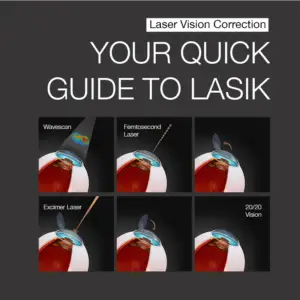
Patient Profile: Preferred vision correction procedure for thick and healthy corneas. Myopia, hyperopia, presbyopia or astigmatism. Ideal for treating lower prescriptions. Depending on the rest of the cornea structure dioptre’s of up to 10D could be treated.
Surgery Overview: This procedure is performed in a laser theatre with mild sedation. Cornea thickness is measured and mapped. Numbing drops are applied, and an eyelid holder is used. A laser creates a corneal flap, which is lifted to expose underlying tissue. The excimer laser reshapes the cornea to correct vision. The flap is repositioned and heals naturally.
Recovery: Least discomfort and fastest healing time. Vision typically clears within 24 hours. Common side effects include mild discomfort and blurred vision usually resolving within a day. Dry eyes and light sensitivity is associated with most procedures and improve over a time of about 3 months.
Post-Op Care: Avoid makeup and dust for a few days and swimming for 1 month. Wear sunglasses outdoors. Use eye shields while sleeping for 1 week. Most patients can return to work the day after surgery.
PRK Surgery
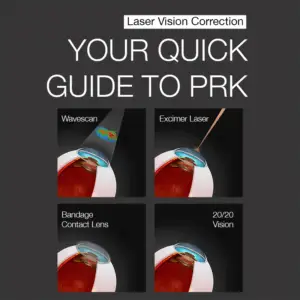
Patient Profile: Preferred vision correction procedure for thinner corneas. Myopia, hyperopia, presbyopia or astigmatism. High prescriptions of up to about 10D that do not qualify for LASIK could possibly qualify for PRK.
Surgery Overview: This procedure is performed in a laser theatre with mild sedation. Similar to LASIK, the cornea is measured and mapped. Numbing drops are applied. The laser reshapes the cornea’s surface without creating a flap. A bandage contact lens is applied post-surgery.
Recovery: Healing takes longer than LASIK, with discomfort and blurry vision lasting 3-4 days. Full clarity may take 3-6 months. Dry eyes and light sensitivity is associated with most procedures and improve over a time of about 3 months.
Post-Op Care: Wear sunglasses for 6 months outdoors. Avoid makeup and dust for a few days and swimming for 1 month. Return to work typically 1 week post-surgery.
Implantable Contact Lens (ICL) Surgery
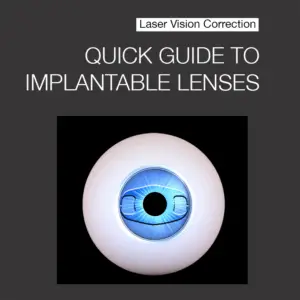
Patient Profile: Vision correction procedure for those who do not qualify for other options due to the condition of the cornea or a very high prescription. Designed to correct high myopia ranging from −5 to −20 D. Myopia, hyperopia, presbyopia or astigmatism.
Surgery Overview: This procedure is performed in a hospital operating theatre under sedation. Tiny, self-sealing incisions are made at the edge of the cornea. A lens is implanted between the cornea and iris. Almost like a contact lens implanted in the eye. A small draining hole is made in the coloured part of the eye to prevent pressure build up, this is called an iridotomy.
Recovery: Vision improves to about 80% within a day, with full clarity over 1-6 weeks. You can return to work within 2 days. Dry eyes are associated with most procedures and improve over a time of about 3 months.
Post-Op Care: Rest and avoid strenuous activities for 2 weeks. Avoid makeup and dust for a few days and swimming for 1 month. Wear sunglasses outdoors. Use eye shields while sleeping for 1 week.
Custom Lens Replacement Surgery
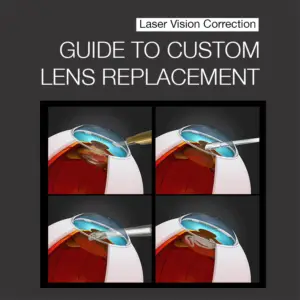
Patient Profile: Ideal for mature patients anticipating cataracts. If your refractive surgeon predicts that cataracts may soon begin clouding your lens, Custom Lens Replacement could be an excellent solution. This procedure not only delivers outstanding visual results but also pre-empts the need for cataract surgery in the near future. Can correct myopia, hyperopia, presbyopia and astigmatism.
Surgery Overview: This procedure is performed in a hospital operating theatre under sedation. 2-3 tiny self-sealing incisions are made. The natural lens is replaced with a multifocal intraocular lens (IOL) to correct vision, similar to cataract surgery.
Recovery: Full focus may take 6-8 weeks, with gradual vision improvement during this period. About 10% will still require glasses for either distance, intermediate or near vision or a combination of these especially with prolonged tasks. You can return to work within 2 days. Dry eyes are associated with most procedures and improve over a time of about 3 months. Some visual side effects, like halos, may occur but typically improve over time.
Post-Op Care: Rest and wear UV-protected sunglasses outdoors. Avoid strenuous activities for 2 weeks. Avoid makeup and dust for a few days and swimming for 1 month. Wear sunglasses outdoors. Use eye shields while sleeping for 1 week.
Share this Blog Post
Contact Us
Recent Sight Stories

Advancing Vision Correction in South Africa: First Artiplus Lens Procedure Performed by Dr Lourens Coetzee
Precision in sight – Dr Lourens Coetzee holds up an enlarged model of the Artiplus Phakic Implantable Lens, representing a breakthrough in the correction of presbyopia. South Africa has entered

Clear Vision, Her Way: Why More Women Are Choosing LASIK
In honour of Women’s Day, we explore how clear vision empowers women to live confidently, freely, and on their own terms, and why women are considering vision correction like LASIK.

LASIK: A Shift in Perspective on Clear Vision
| Written by Dr Yolandie Coetzee July marks Global Vision Correction Month—a time to reflect on how far we’ve come in restoring sight and improving lives. Whether through glasses, contact

What’s Causing Your Blurry Vision? A Guide to Refractive Errors
If you’ve ever struggled to see clearly—whether at a distance, up close, or both—it may be due to a refractive error. The most common types include nearsightedness (myopia), farsightedness (hyperopia), astigmatism, and presbyopia. These conditions
